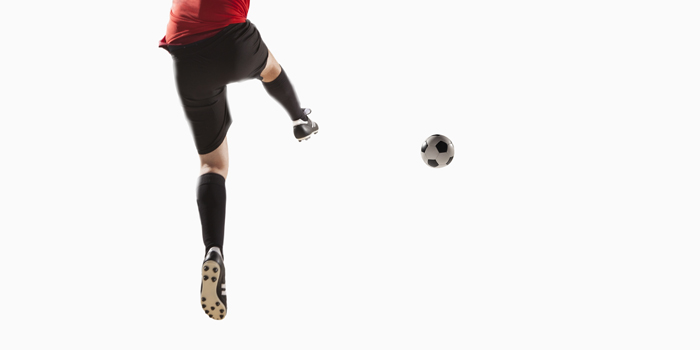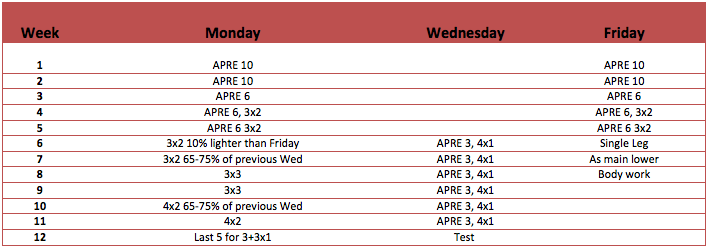
I originally wrote about how we tweaked the APRE protocol months ago. Since then, we’ve made a few more tweaks and come up with something a little more set in stone. We also gave it a shot with a couple more teams this spring.
If you haven’t read the original article on this topic, you can find it here. In summary of the last article, I had used the APRE Method with great results in the past. We played around with some cluster sets last summer with a few athletes who were on campus training with us. We liked how it worked and decided to utilize this with teams last fall. What we did was:
- Warm-Up Set 1
- Warm-Up Set 2
- Set 3: Max reps and weight adjusted based on Dr. Mann’s tables
- Set 4: Instead of max reps, we went with 3x2 or 4x1, depending on the APRE protocol used.
These ended up not being cluster sets. Logistically, we felt it would take too long and it worked better for us to just do straight sets as part of a circuit. For example, we might have programmed a box jump, squat and upper body activation or lower body mobility exercise as the circuit.
MORE: On-Court Results with APRE Cluster Method
During the spring semester, we programmed out the entire 12 weeks utilizing this approach. We ended up getting through all of it with two of the three teams we started it with. We squatted Monday and Friday for the first five weeks, then Monday/Wednesday for weeks six through 12. Bulgarian Split Squats became our main lower body movement on Fridays starting with week six. This was our progression for the semester:
Note: Spring Break fell between weeks 6 and 7
What We Wanted and What Was Different for This Semester
We wanted to see improvements in our vertical, agility, and 20-yard sprint times, so we added in a jumping exercise that hadn’t been there in the past. We had a jump in our warmup and a jump within the actual training, prior to or after our main lower body movement. We chose from vertical, horizontal, lateral or rotational jumps. We chose based on the sport, but would pick two every day from different categories. We wrote out a progression for each jump category and stuck to it. Also, with these two teams, we were able to do a little bit of movement training. For us, that’s a lot of short sprints (5-10 yards) and some shuttle agility work.
What Happened
We got stronger. We were working with a good number of freshmen, though, so anything would make them stronger. Similar to the fall semester and working this type of program with some other teams, we probably saw similar improvements in strength as the regular APRE protocol without going for two max rep sets. We saw improvements in vertical from women’s soccer across the board. We did not see improvements with our women’s volleyball team, with the exception of one of our older, stronger athletes. 20-yard sprint time and 5-10-5 agility times went down on average across the board. This is to be expected with a young team.
What We Think We Learned
We think we can get stronger with both males and females utilizing the APRE protocol or by using a variation where we perform one max rep set and then multiple sub-max rep sets. On average, with all of the athletes we did this with, we saw an improvement in vertical. When we break it down to team, we did not see the improvement in women’s volleyball that we expected. There could be a number of reasons for this, but the bottom line is that we feel like they should be improving on this. Making our athletes stronger and having the ability to sprint them and work some movement, even a low volume, got them better at those tests. This is not surprising.
Our first day of squatting starting at week six was meant to be a speed or technique reinforcement day. We have the percentages from 65-75%, but this was really an eyeball adjustment we made. We know that with the squat and especially with females, they might hit 20 reps with 80% and only five reps with 85%. So if the speed and technique looked good, we let them increase weight. We have a phone app called BarSense that we have used to look at some speeds. It may not be the most accurate measurement, but we’ve used it enough to feel comfortable with it. When we say the speed looks good, we are probably talking above .6 meters/second. We have no way of knowing, but we think that first day of squatting helped us with only technique reinforcement.
What’s Next
We’ve recently heard more about getting really good at jumping and sprinting in a straight line, or vertically and horizontally. Once you are good at that, you can introduce jumping in more planes. Even agility training may be overdone because of the amount a team sport athlete gets through their sport, especially early in an off-season.
Also, we could just go straight tri-phasic on Monday to help engrain technique better. I’ve never gotten to the point with a team where I feel comfortable utilizing Coach Dietz’s program as written, but we’ve had success in utilizing an eccentric and isometric phase to help athletes learn how to perform movements better. Lastly, in an ideal world, we would have four levels—primarily grouped in classes, but more so strength levels—and have each group perform a different protocol for the main exercise. I was originally introduced to something like this from Coach Watts who had a four year development model, and was reminded of this at the Juniata clinic by Coach DeMayo who had his own version. Ours would look like this:
Freshmen – Linear periodization, working from 20 down to five or six reps
Sophomore – APRE as written
Junior – APRE with clusters last set
Senior – Velocity based training
Is this logistically possible? It might be this year or next year, now that everyone (except the freshmen) have had two years of training with us, know what’s going on, and know what to expect.
We will continue to tweak this program to make it work best for our student-athletes. Any feedback, comments, questions or opinions are greatly appreciated.
Bobby Fisk is the head strength and conditioning coach at NJIT and can be reached at fisk@njit.edu.











2 Comments